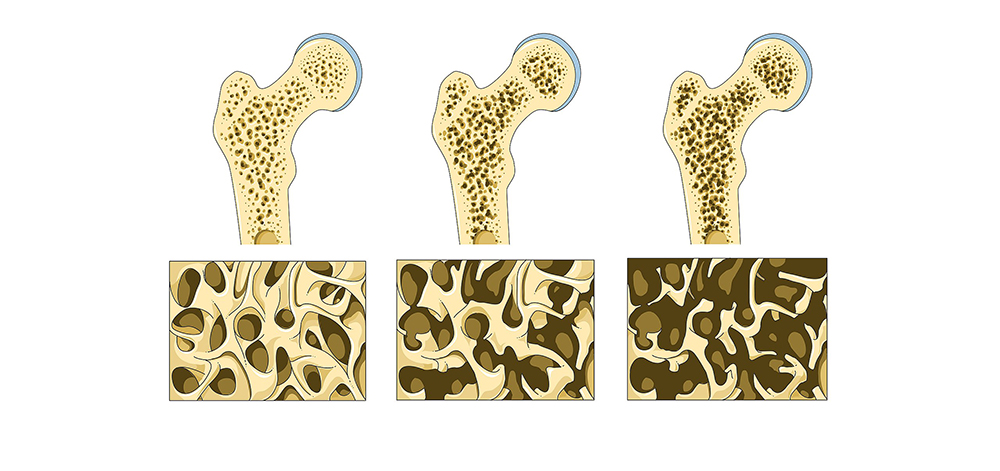Mechanosensitive receptor offers new approach to osteoporosis treatment
Researchers have identified GPR133/ADGRD1, a mechanosensitive adhesion G protein-coupled receptor, as a promising therapeutic target for osteoporosis. The receptor responds to both mechanical forces and molecular signals, enhancing bone formation through cAMP-dependent activation of β-catenin signalling. A novel small-molecule agonist significantly alleviated osteoporosis in preclinical models, suggesting potential for clinical development.
Receptor deficiency reveals critical role in bone homeostasis
Scientists at the University of Leipzig and Shandong University have discovered that the adhesion G protein-coupled receptor GPR133/ADGRD1 plays a fundamental role in bone formation, opening potential pathways for treating osteoporosis and related skeletal disorders. The research, published in Signal Transduction and Targeted Therapy, demonstrates that this receptor integrates mechanical and molecular signals to regulate osteoblast differentiation and function.
The team, led by Dr Juliane Lehmann, Professor Jin-Peng Sun, and Professor Ines Liebscher, generated constitutive and osteoblast-specific knockout mouse models to investigate GPR133/ADGRD1’s physiological role. “Constitutive and osteoblast-specific knockouts of Gpr133/Adgrd1 in mice lead to reduced cortical bone mass and trabecularization in the femurs and vertebrae – features characteristic of osteoporosis,” the authors report. The receptor-deficient mice exhibited decreased bone mineral density, reduced cortical thickness, and compromised bone strength, mirroring key hallmarks of human osteoporotic disease.
Molecular mechanism links mechanical forces to bone formation
The research revealed that GPR133/ADGRD1 operates through a sophisticated dual-activation mechanism. The receptor responds to mechanical strain applied to bone tissue whilst simultaneously interacting with its endogenous ligand, protein tyrosine kinase 7 (PTK7). This combination triggers a signalling cascade involving cyclic AMP (cAMP) accumulation and subsequent activation of the β-catenin pathway, which is essential for osteoblast differentiation.
“At the molecular level, GPR133/ADGRD1 regulates osteoblast function and differentiation through a combined activation mechanism involving interaction with its endogenous ligand, protein tyrosine kinase 7 (PTK7), and mechanical forces,” the authors explain. The team demonstrated this mechanism through stretch assays in vitro and mechanical loading experiments in vivo, showing that both stimuli synergistically enhance receptor activity.
The signalling pathway analysis revealed that GPR133/ADGRD1 activation prevents β-catenin degradation by interfering with glycogen synthase kinase-3 (GSK3)-dependent phosphorylation. This stabilisation of β-catenin promotes the expression of key osteogenic markers including alkaline phosphatase, osteocalcin, and runt-related transcription factor 2 (RUNX2), driving osteoblast maturation and bone matrix production.
Small-molecule agonist reverses osteoporosis in preclinical models
A significant translational development emerged from testing AP-970/43482503 (AP503), a receptor-specific small-molecule agonist previously identified through structure-based virtual screening. When administered to wild-type and heterozygous knockout mice, AP503 significantly enhanced bone formation markers and increased bone volume, trabecular number, and cortical thickness. The compound proved particularly effective in an ovariectomy mouse model of postmenopausal osteoporosis, where it substantially restored bone parameters towards normal levels.
“Activation of GPR133/ADGRD1 with the receptor-specific ligand AP-970/43482503 (AP503) enhances osteoblast function and differentiation, both in vitro and in vivo, significantly alleviating osteoporosis in a mouse ovariectomy model,” the authors state. The therapeutic effects extended beyond bone formation, as AP503 treatment also reduced osteoclast activity, addressing both sides of the bone remodelling imbalance that characterises osteoporosis.
Exercise and receptor activation show synergistic effects
The researchers conducted treadmill exercise experiments demonstrating that mechanical loading synergises with pharmacological receptor activation. Mice subjected to controlled exercise protocols showed enhanced bone formation, but the combination of exercise and AP503 treatment produced superior results compared to either intervention alone. This finding suggests that GPR133/ADGRD1 activation could amplify the beneficial skeletal effects of physical activity.
The study documented reduced serum levels of procollagen type I amino-terminal propeptide (P1NP), a bone formation marker, and elevated C-terminal telopeptide (CTX), a bone resorption marker, in receptor-deficient mice. These biochemical changes correlated with decreased osteoblast numbers and impaired bone formation rates measured through calcein double-labelling. Importantly, the reduced osteoblast function led secondarily to increased osteoclast activity through decreased osteoprotegerin secretion, creating a cascade favouring bone loss.
Implications for osteoporosis therapeutics
The research addresses a critical clinical need, as current osteoporosis treatments often present significant limitations. Bisphosphonates can cause atypical fractures with prolonged use, whilst parathyroid hormone therapy provides benefits only within a limited two-year window. The identification of GPR133/ADGRD1 as a druggable target offers a mechanistically distinct approach that simultaneously promotes bone formation and suppresses resorption.
“These findings position GPR133/ADGRD1 as a promising therapeutic target for osteoporosis and other diseases characterized by reduced bone mass,” the authors conclude. The receptor’s dual responsiveness to mechanical and molecular signals presents unique therapeutic opportunities, potentially allowing treatments to harness the body’s natural mechanosensory pathways.
The research also identified functionally significant single nucleotide polymorphisms in human GPR133/ADGRD1 that reduce receptor signalling. Such variants may represent genetic risk factors predisposing individuals to early-onset or treatment-induced osteoporosis, suggesting that receptor activation strategies could prove particularly valuable for these populations.
Future clinical translation will require validation in human patient samples and determination of optimal dosing strategies. The authors acknowledge that whilst mouse models provide valuable insights into skeletal disorders, structural differences between murine and human bone necessitate cautious interpretation. Nevertheless, the robust preclinical efficacy data, combined with the receptor’s established role in human bone mineral density variation, support continued development of GPR133/ADGRD1-targeted therapeutics.
Reference
Lehmann, J., Lin, H., Zhang, Z., et. al. (2025). The mechanosensitive adhesion G protein-coupled receptor 133 (GPR133/ADGRD1) enhances bone formation. Signal Transduction and Targeted Therapy, 10(1), 199. https://doi.org/10.1038/s41392-025-02291-y


